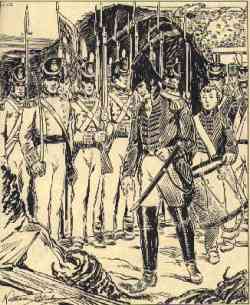Second Battle of Fort Bowyer |
||
|---|---|---|
| Date | Tuesday, February 7, 1815 | |
| Weather | Cloudy and cool - 48 degrees | |
| Location | Fort Bowyer, Alabama | |
British Empire |
United States |
|
| Belligerents | United Kingdom | The United States of America |
| Commanders | John Lambert | William T. Lawrence |
| Casualties |
Force: 1,400 Killed: 13 Wounded: 18 Captured: 0 |
Force: 375 Killed: 1 Wounded: 10 Captured: 364 |
|
ConstructionMobile had been a Spanish possession before the beginning of the war, but Congress had declared it part of American territory after commencement of the war. After Spanish forces evacuated Mobile in April 1813, the Americans built a redoubt on Mobile Point. In June 1813, Colonel John Bowyer completed the fort, but the Americans abandoned it about a year later. Then in August 1814, they garrisoned it again with 160 men under Maj. William Lawrence. The fort was made of sand and logs, and fan-shaped, with the curved face facing the ship channel into Mobile Bay. On the landward side there was abastion, flanked by two demi-bastions. The purpose of the fort was to impede any British invasion at this point on the Gulf Coast. OverviewThe British made two attacks on the Fort. The first, which failed, took place in September 1814. The second attack, in which the British were successful, took place in February 1815, after the Treaty of Ghent had been signed but before the news reached that part of America. BackgroundThe Second Battle of Fort Bowyer was the first step in a British campaign against Mobile, but turned out to be the last land engagement between British and American forces in the War of 1812. After the unsuccessful British attack in September 1814, American General Andrew Jackson, recognizing Fort Bowyer's strategic importance, ordered the fort strengthened. Its garrison comprised 370 officers and men of the 2nd Infantry Regiment, and Jackson proclaimed "ten thousand men cannot take it". British forces under General John Lambert decided to attack Mobile again. The commander of the naval forces was Captain T.R. Rickets of the 74-gun Third Rate ship of the line, HMS Vengeur.[15]The British troops came from the 21st (Royal North British Fusiliers) Regiment of Foot, who had fought at the New Orleans. When they captured the fort, the British discovered that it mounted three long 32-pounders, eight 24s, six 12s, five 9s and a mortar and a howitzer. However, Fort Bowyer's weakness was its vulnerability to an attack from the landward side. BattleThe British campaign began with an investiture of Fort Bowyer. Lambert landed a force of around 1,400 men east of the fort to block any reinforcements by land. Judging they would need a line ofartillery to successfully reduce the fort, the troops brought with them four 18-pounders cannons, two 8-inch howitzers, two 6-pounder rockets, three 5 1/2-inch and two 4.4-inch mortars, and a hundred 12-pounder rockets for a siege. The British moved to within 200 yards of the fort and began to build their siege works. While they were constructing their artillery works, the British forces endured constant American fire and took light casualties, but continued their work undeterred. When the siege guns were in place, the British were ready to launch a devastating artillery attack on the now vulnerable wooden fort. On February 12 after a small barrage of artillery, Lambert, under a flag of truce, called on the fort to surrender. He asked the American commander, Major William Lawrence, to accept British terms and prevent the needless slaughter of his men. Lawrence reluctantly agreed to do so. Fort Bowyer surrendered after a five-day siege. AftermathWith Mobile Bay secured by British warships and Fort Bowyer now under British control, the remaining American forces in the area hurried to Mobile to prepare for the expected onslaught there. The British postponed the attack on Mobile itself when HMS Brazen arrived some two days later, carrying news that the Treaty of Ghent, ending the war, had been signed on the previous Christmas Eve. When news of ratification of the Treaty arrived, the British withdrew. The final attachment of Mobile to the United States was the only permanent exchange of territory during the War of 1812. Fort Bowyer subsequently reverted to U.S. control. The US would later replace it with the more heavily fortified Fort Morgan. |
||
 Fort Bowyer was a fort the Americans erected on Mobile Point situated at the mouth of Mobile Bay. Built during the War of 1812, it no longer exists because in 1864 the US Government built Fort Morgan on the site. The fort was the site of two attacks by the British. The first, unsuccessful, attack led to the British changing their strategy and attacking New Orleans. The second attack, after their defeat at the Battle of New Orleans, was successful, but came after the end of the war.
Fort Bowyer was a fort the Americans erected on Mobile Point situated at the mouth of Mobile Bay. Built during the War of 1812, it no longer exists because in 1864 the US Government built Fort Morgan on the site. The fort was the site of two attacks by the British. The first, unsuccessful, attack led to the British changing their strategy and attacking New Orleans. The second attack, after their defeat at the Battle of New Orleans, was successful, but came after the end of the war.